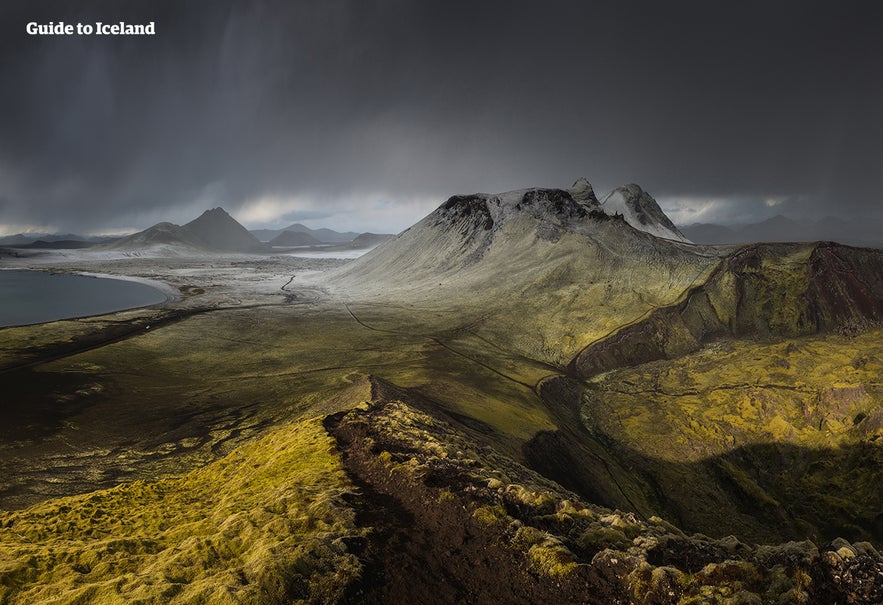아이슬란드의 고원지대는 국토의 대부분을 차지하며, 인상적인 자연 명소들이 자리한 곳입니다. 고원지대는 북적이는 관광 인파, 소음 및 번잡함에서 벗어나 고요함과 평온함을 즐기고, 평화로운 분위기에서 때묻지 않은 자연의 아름다움을 만끽할 수 있는 곳입니다.
아이슬란드 고원지대 투어를 통해 이 지역을 탐험해보세요. 등산객들과 사진작가들이 즐겨 찾는 고원지대는 6월부터 9월까지 방문할 수 있습니다.
저희의 콘텐츠를 신뢰할 수 있는 이유
가이드투아이슬란드는 아이슬란드에서 가장 믿을 수 있는 여행 플랫폼으로, 매년 수백만 명의 여행객이 저희와 함께 아이슬란드를 방문합니다. 저희의 모든 콘텐츠는 아이슬란드를 누구보다 잘 아는 현지 전문가들이 작성하고 검토하므로, 정확하고 신뢰할 수 있는 최신 여행 정보만 제공합니다.
중앙 고원지대
중앙 고원지대는 해발 500미터 이상의 광활한 지역으로, 해발 1,000~2,000미터에 이르는 산이 셀 수 없이 많은데요. 이 높은 산들은 대부분 빙하로 덮여 있습니다.
아이슬란드에서 가장 높은 산은 유럽에서 가장 큰 빙하인 바트나요쿨 아래 고원지대에 위치해 있습니다. 바로 그 높이가 약 2,109미터에 달하는 흐반나달스흐뉴쿠르이지요. 헬리콥터 투어를 통해 이곳을 방문해 볼 수 있습니다. 또 다른 주목할 만한 산으로는 바트나요쿨 북서쪽에 있는 빙하 아래에 자리한 화산인 바르다르분가가 있으며, 그 높이는 약 2,000미터에 달합니다.
아이슬란드에서 가장 큰 3대 빙하는 모두 중부 고원지대에 자리하고 있는데, 바트나요쿨은 그 중 하나예요. 나머지는 아이슬란드 중앙에 있는 호프스요쿨과 호프스요쿨 서쪽에 자리한 랑요쿨입니다.
빙하 사이로 여러 갈래의 고원지대 도로가 나있는데요. 이 도로들은 보통 6월에 개통되지만, 기상 상황에 따라 7월로 미뤄지기도 합니다. 주요 도로 중 하나는 아이슬란드의 남부와 북부를 잇는 쿌루르입니다. 호프스요쿨과 랑요쿨 사이에 위치하며 유문암 산맥과 지열 오아시스 지역을 통과하지요.
남부와 북부를 연결하는 또 다른 주요 도로로는 호프스요쿨과 바트나요쿨 사이에 난 스프렌기산두르가 있습니다.
랑요쿨 서쪽의 칼디달두르 역시 씽벨리르(Þingvellir)에서 보르가르피오르두르(Borgarfjörður) 지역으로 이어지는 중요한 고원지대 도로입니다.
아이슬란드의 고원지대를 구성하는 자연 환경은 매혹적인 만큼이나 섬세하고 연약하다는 점을 항상 기억하세요. 작은 면적에 가해지는 사소한 손상이 침식과 돌이킬 수 없는 결과를 초래해 결과적으로 넓은 면적의 환경을 훼손할 수 있습니다. 따라서 고원지대를 방문할 때는 환경 보호를 위한 여행 에티켓을 지켜주시길 바랍니다.
비포장도로와 지정된 도로를 벗어나는 운전은 엄격히 금지되며 무거운 벌금형에 처해질 수 있습니다. 이끼는 섬세하기 때문에 제거는 물론, 그 위에서 걷거나 야영을 해서는 안 되며, 낚시도 엄격하게 규제됩니다.
남부 고원지대
빙하 남쪽의 거의 모든 산은 빙하기에 형성된 응회암 산입니다. 화산 활동은 응회암 지역에 국한되어 있으며, 남부 고원지대에는 아이슬란드에서 가장 활발하게 활동하고 있는 화산들이 자리하고 있는데요. 그 예로는 헤클라, 에이야퍄틀라요쿨, 아이슬란드에서 네 번째로 큰 빙하인 미르달스요쿨 아래에 있는 카틀라 화산 등이 있습니다.
에이야퍄틀라요쿨은 이 화산들 중에서도 가장 유명한 화산입니다. 2010년에 폭발했을 때 유럽 전역의 항공 여행에 큰 혼란을 일으켰고, 이 뉴스를 본 전세계의 시청자들이 이 지명의 발음을 알아듣지 못해 E11이라는 별명이 붙었습니다.
남부 고원지대에는 아이슬란드 최고의 하이킹 및 온천 명소 중 하나인 란드만날라우가르도 있습니다.
북동부, 중북부 및 북서부 고원지대
고원지대의 북동쪽에는 라카기르 분화구와 유명한 빙하 기슭의 호수와 동명의 화산인 그림스보튼, 오라이파요쿨 빙하 등이 있습니다. 바트나요쿨 북쪽에서 가장 잘 알려진 화산은 아스캬와 크라플라입니다.
또한 이 지역에는 유럽에서 가장 강력한 폭포인 데티포스가 있는 요쿨사르글류푸르 협곡이 있습니다.
북서부와 중북부 고원지대는 이스트피오르드를 구성하는 산들처럼 고대 현무암 지층으로 이루어져 있습니다.
고원지대 오아시스
고원지대에는 독특한 초목과 야생동물이 서식하는 오아시스들이 있는데요. 그중 가장 중요한 오아시스로는 쑈르사르베르, 니달두르/요쿨달루르, 헤르두브레이달린디르, 에이야박카르 등을 꼽을 수 있습니다. 쑈르사르베르와 에이야박카르는 분홍발 큰기러기의 주요 서식지이며, 쑈르사르베르는 1990년에 람사르 습지로 지정되었습니다.
야생 순록은 동쪽 고원지대에 서식하며, 이곳이 아이슬란드에서 순록을 볼 수 있는 유일한 곳입니다. 처음에는 농사를 짓기 위해 들여왔지만, 이후 산업이 발달하면서 무리를 지어 자유롭게 돌아다니고 있습니다.











